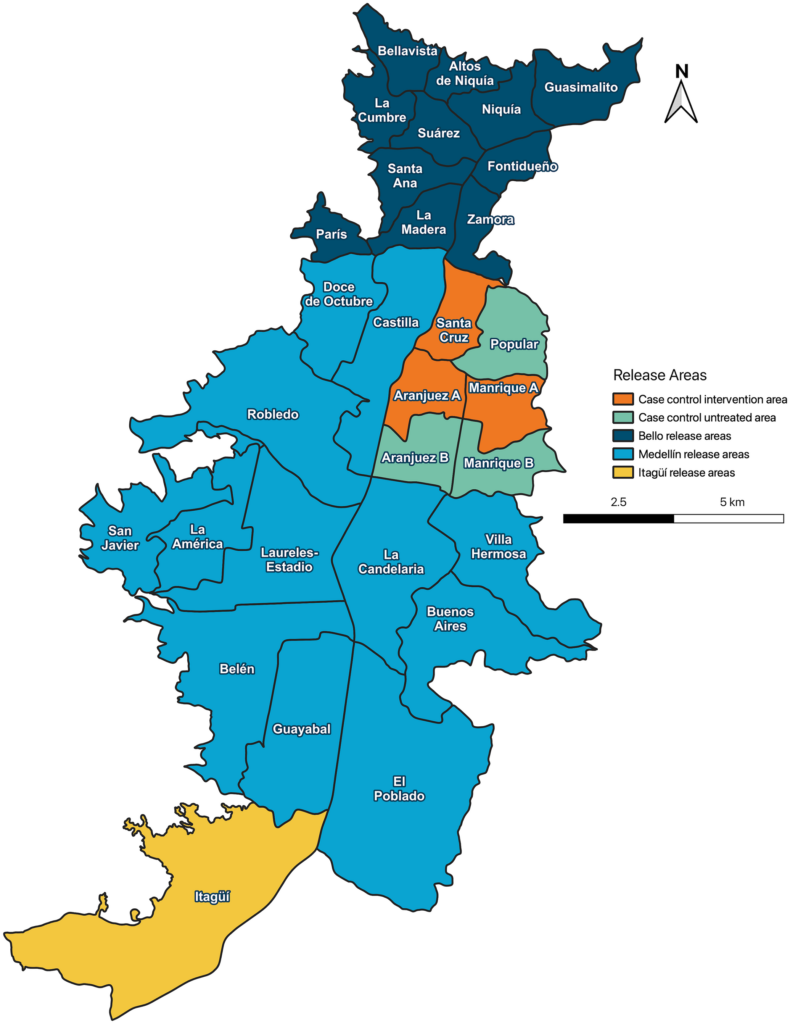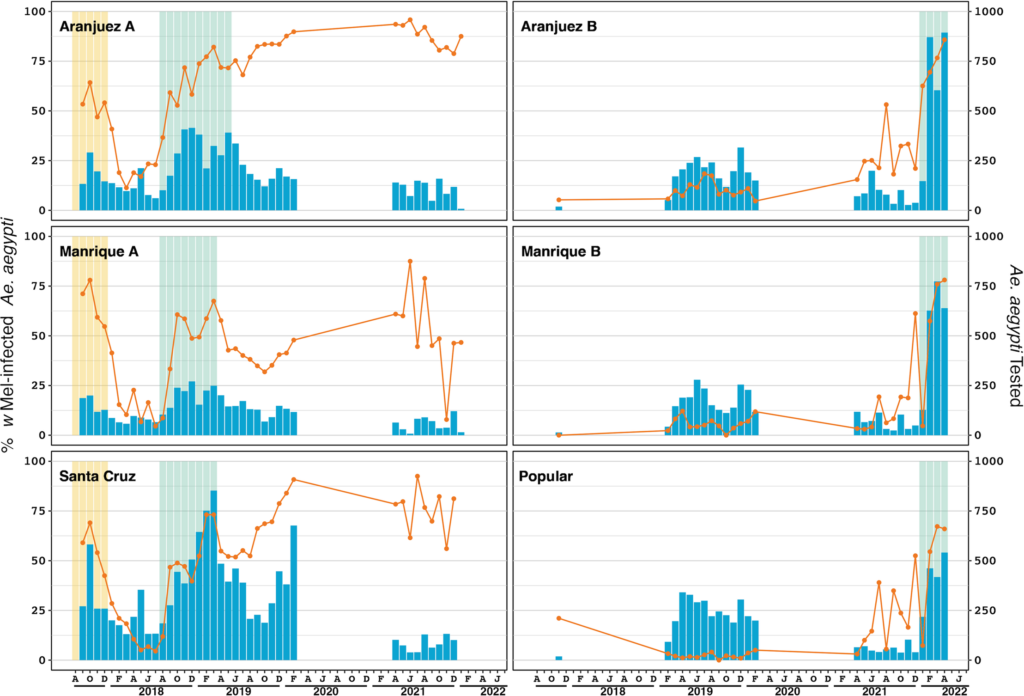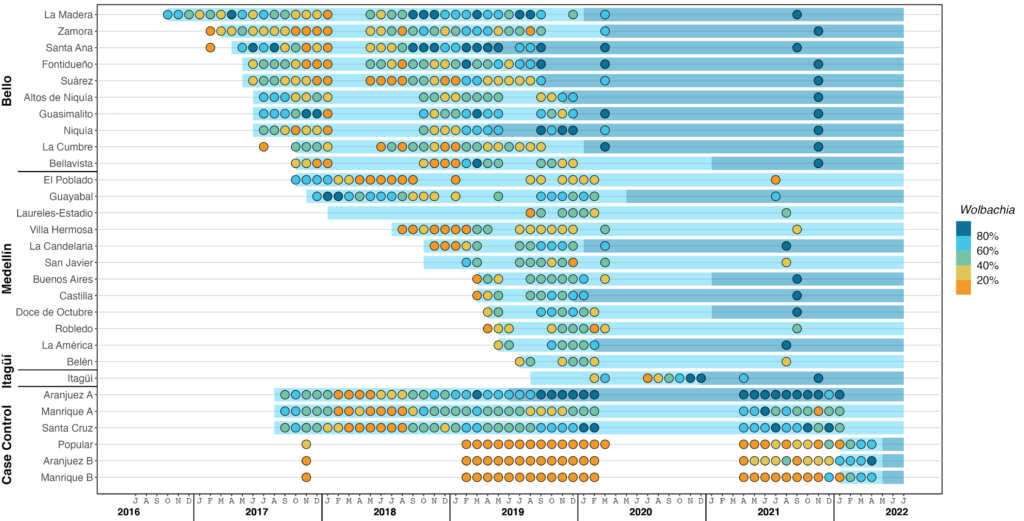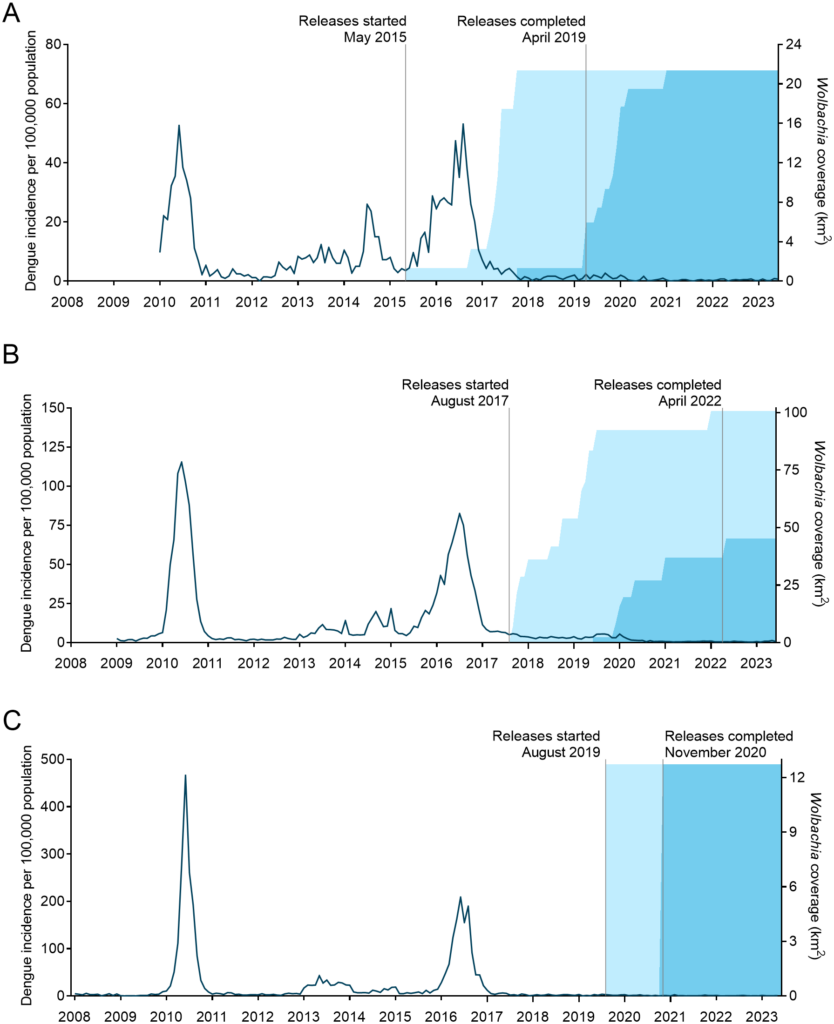
Dengue viruses, transmitted by Aedes mosquitoes, are the most important arboviruses globally, with over 4.5 million cases and 4,000 deaths reported globally so far in 2023. Cases have escalated dramatically in the last 20 years, with an eight-fold increase from half a million cases in 2000 to over 4.2 million in 2022. Climate change exacerbates this trend, with predictions indicating that by 2080, an additional 2.25 billion people could be at risk, potentially affecting over 60% of the world’s population.
Wolbachia, a naturally occurring bacterium, has been effectively utilized by the World Mosquito Program to combat dengue transmission. By infecting Aedes aegypti mosquitoes with Wolbachia, the mosquitoes’ ability to transmit dengue is significantly reduced. This method, involving the release of Wolbachia-infected mosquitoes into the wild, has been instrumental in decreasing dengue transmission rates in various regions, offering a sustainable and environmentally friendly approach to controlling vector-borne diseases. I last reported on this very promising method in the fall of 2021, when they presented results of it’s effectiveness in Indonesia. Now, a pair of papers (here and here) have been published in the journal PLOS Neglected Tropical Diseases on the largest contiguous scale of releases Wolbachia-infected mosquitoes to date, which took place in Colombia, and the impact of those releases on dengue infections. While there has been some media coverage of this campaign, I was not fully aware of it until I read these papers. Having read them, they read like a wonderful story that could be published as a novel with a great narrative arc. So here, I’ll try to briefly present what the staff of the World Mosquito Program and the communities they collaborated with accomplished.

Act 1: The Beginning
The World Mosquito Program in Colombia started to conduct a small pilot project in the comuna of Paris in the city of Bello in the Aburrá Valley of Colombia between June 2015 and August 2016, releasing both adults and eggs of the wMel-COL Aedes aegypti mosquito line with support and collaboration with the local community. Wolbachia spread quickly in the local mosquito population, reaching 80% prevalence in the initial release area by the end of 2016.
Act 2: Sudden threat and scale-up of implementation
For those of you who forgot, these were also the years marked by first the chikungunya and then the Zika virus epidemics. The sudden threat of these two additional Aedes-borne arboviruses, and the success of the pilot project in Paris, facilitated the scale-up of the implementation of Wolbachia-infected mosquito releases in 2016 and 2017 across the cities of Bello and Medellin, covering an area of 135 km2, with a combined population of 3.3 million people, making it the largest contiguous scale of implementation for the World Mosquito Program to date. Given the large area, wMel-COL Aedes mosquitoes were released from moving vehicles traveling on publicly accessible roads. Importantly, the wMel-COL mosquito line did not contain resistance genes against pyrethroid insecticides.
Act 3: A bump in the road
While Wolbachia prevalence was relatively high in tested mosquitoes during these releases, the proportion of mosquitoes harboring this fascinating bacterium plummeted once mosquitoes were not released. This had to do with the fact that routine mosquito control was continuing in these cities, specifically with pyrethroid insecticides. Local mosquitoes developed a resistance to this insecticide, while the released mosquitoes, and their progeny, were the ones being killed by well-meaning vector control staff. This must have been frustrating to realize! However, the team at the World Mosquito Program Colombia came up with an ingenious and very counter-intuitive solution: just make the Wolbachia-bearing mosquitoes also resistant to pyrethroid insecticides. Now, normally, releasing insects that have a built-in insecticide resistance gene wouldn’t sound like a great idea, because it would make eliminating them harder, and potentially introduce or increase insecticide resistance in the target population. However, in this case, the wild-type mosquito population in these cities were already resistant to insecticides, so releasing mosquitoes that are just as resistant as them should not have cause harm. Convincing regulatory agencies of this could have been difficult, I imagine! With that knowledge, the team created a second mosquito line, wMel-COL2, still containing Wolbachia, but now with added insecticide resistance.

Act 4: Finally, success
With the second line in hand, the staff and the community collaborated to restart releases in 2018 and 2019, both in Bello and Medelin, as well as in the city of Itagui. A case-control study was also conducted with three areas of Medelin designated as treatment areas, and adjacent three areas designated as control areas. Mosquitoes were released in the treatment areas in 2019, and patients showing symptoms of dengue were enrolled in an epidemiological study in both treatment and control areas. Wolbachia prevalence was consistently high both during and after mosquito releases, and data was collected on the impact of the intervention on dengue cases when…

Act 5: The world stops
Of course, the COVID-19 pandemic hit just as the trial was approaching it’s end. It stopped all mosquito releases, severely limited monitoring of Wolbachia levels in mosquitoes and enrollment in the case-control epidemiological study. Fortunately, mosquitoes continued mating, and Wolbachia continued spreading between mosquitoes, using it’s signature cytoplasmic incompatibility superpower to increase it’s prevalence. Releases in Itagui resumed in August 2020, but widespread monitoring of mosquitoes outside of Itagui did not resume until April of 2021. Wolbachia-infected mosquitoes were finally released in the control areas of the case-control study in 2022, after the completion of the epidemiological study.
Act 6: Triumphant results!
And now, we get to see their results! While we were all in social isolation, Wolbachia levels have increased to exceed 80% of mosquitoes tested in all of Bello and Itagui. Results in Medellin are a bit more heterogeneous, with some areas having as low as 20% prevalence. The authors suggest that this is because Medelin has many high-rise buildings and gated communities, which were not accessible by car, as mosquitoes were released. Crucially, dengue cases across the entire area have plummeted by 95-97% compared to the prior decade. While this could be due to lower dengue transmission overall, dengue cases were also substantially lower in the treatment areas in the case-control study compared to the control areas. The case-control itself had insufficient numbers of participants enrolled to provide reliable comparison between the risk of exposure to dengue in treatment vs control areas, which could also be because Wolbachia suppressed dengue transmission even in areas that were not treated specifically.

The above studies provide excellent news for the future promise of the Wolbachia methodology to curb the spread of dengue and other arboviruses transmitted by Aedes mosquitoes. The effectiveness of the method at such a large scale should facilitate its spread to other countries and regions of the world at risk of these viruses. I’m looking forward to the day of visiting some of these locations and feeling gratitude to the staff at the World Mosquito Program for making these places (and the mosquitoes at them) safe to be around for both local residents and tourists. I also very much appreciated the complexity of all the challenges they had to overcome to achieve this victory, including the counterintuitive nature of having to release insecticide-resistant mosquitoes for success. It’s such a great story, so I hope an author or a producer reading this blog post will be inspired to write a novel or make a movie out of it. The World Mosquito Program and the local community more than deserve it!

Comments